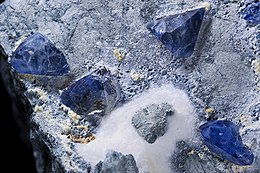Benitoite
| Benitoite | |
|---|---|
 Benitoite on natrolite | |
| General | |
| Category | Cyclosilicate |
| Formula (repeating unit) | BaTiSi3O9 |
| Strunz classification | 9.CA.05 |
| Crystal system | Hexagonal |
| Crystal class | Ditrigonal dipyramidal (6m2) H-M symbol: (6 m2) |
| Space group | P6c2 |
| Unit cell | a = 6.641, c = 9.7597(10) [Å]; Z = 2 |
| Identification | |
| Color | Blue, colorless |
| Crystal habit | Tabular dipyramidal crystals, granular |
| Twinning | On {0001} by rotation |
| Cleavage | [1011] poor |
| Fracture | Conchoidal |
| Mohs scale hardness | 6 - 6.5 |
| Luster | Vitreous |
| Streak | White |
| Diaphaneity | Transparent to translucent |
| Specific gravity | 3.6 |
| Optical properties | Uniaxial (+) |
| Refractive index | nω = 1.756 - 1.757 nε = 1.802 - 1.804 |
| Birefringence | δ = 0.046 |
| Pleochroism | O = colorless; E = purple, indigo, greenish blue |
| Dispersion | 0.036–0.046[1] |
| Solubility | Insoluble: HCl, H2SO4 Soluble: HF |
| Other characteristics | Blue fluorescence under SW UV; intense blue cathodoluminescence |
| References | [2][3][4] |
Benitoite (/bəˈniːtoʊaɪt/) is a rare blue barium titanium silicate mineral, found in hydrothermally altered serpentinite. Benitoite fluoresces under short wave ultraviolet light, appearing bright blue to bluish white in color. The more rarely seen clear to white benitoite crystals fluoresce red under long-wave UV light.
It was first described in 1907 by George D. Louderback, who named it benitoite for its occurrence near the headwaters of the San Benito River in San Benito County, California.[5][6]
Benitoite occurs in a number of sites, but gemstone quality material has only been found in California. In 1985 benitoite was named as the official state gem of California.[7][8]
Benitoite has a rare 5 pointed crystal form, and an even rarer 6 pointed form, "star of David", with about 24 samples known.[9]
Associated minerals and locations
Benitoite typically occurs with an unusual set of minerals, along with minerals that make up its host rock. Frequently associated minerals include: natrolite, neptunite, joaquinite, serpentine and albite.
Benitoite is a rare mineral found in very few locations including San Benito County, California, Japan and Arkansas. In the San Benito occurrence, it is found in natrolite veins within glaucophane schist within a serpentinite body. In Japan, the mineral occurs in a magnesio-riebeckite-quartz-phlogopite-albite dike cutting a serpentinite body.[4]
-
Blue benitoite crystals on white natrolite, Dallas Gem Mine, San Benito Co., California, US
-
Benitoite crystals under UV light
References
- ^ O'Donoghue, Matthew (2006). Gems: Their Sources, Descriptions and Identification (6th ed.). Oxford: Butterworth-Heinemann. p. 389. ISBN 978-0-75-065856-0.
- ^ WebMineral Listing
- ^ MinDat Listing
- ^ a b Handbook of Mineralogy
- ^ Louderback, George Davis (July 30, 1907). "Benitoite, A New California Gem Mineral". Bulletin of the Department of Geology. 5 (9). University of California Publications: 149–153. OCLC 6255540.
- ^ Wilkins, Al (March 23, 2002). "SCFM News March 02, Featuring Benitoite". Mineralogical Society of Southern California. Retrieved April 3, 2014.
- ^ "Mineral Resources". California Department of Conservation - California Geological Survey. Retrieved April 3, 2014.
- ^ "Benitoite". Gemology Online. Retrieved 8 November 2012.
- ^ Pool, Bob (August 17, 2013). "California visitor's rare find: A star-shaped piece of benitoite". Retrieved April 3, 2014.


